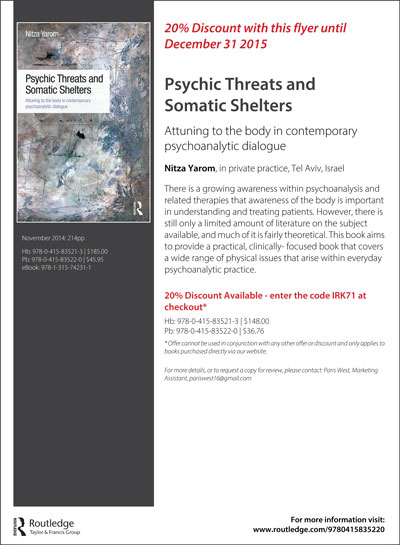Nitza Yarom (Israel)
 My new book, Psychic Threats and Somatic Shelters, is my eighth book, the third in English, within an evolving exploration of the body in the analytic process. It exposes a range of somatic manifestations through which men and women, adults and children, become acquainted with their hidden psychic threats in treatment.
My new book, Psychic Threats and Somatic Shelters, is my eighth book, the third in English, within an evolving exploration of the body in the analytic process. It exposes a range of somatic manifestations through which men and women, adults and children, become acquainted with their hidden psychic threats in treatment.
In noticing the short breath mounting in the young man Joshua’s speech, the therapist says, “There are always more and more things that have to be fixed, until eventually you are out of breath, choking.” Joshua relaxes, uttering, “It’s a good point.” Yvonne, a middle-aged woman, in a dissociated sentence, says, “I know that in my body I feel this marriage,” while reporting, in the next session, that her blood pressure is rising. The seven-year-old Peter insists to his therapist, “I don’t want to hear your voice—turn around,” a trying experience for her. The aging Anna says to her analyst, “It seems to me that as long as my eyes are not a hundred percent right, I need you.”
In the book’s two parts, Somatic Shelters and Embodied Dialogue, a vast range of physical issues and encounters is explored: breathing difficulties; sensory and motor experiences related to sight, sound, touch, smell, taste and movement; issues of weight gain and loss; various physical and psychic pains; and numerous ailments developing within family relationships, such as in marital relations and between parents and children.
The value of this book is in enabling the treatment to become body-attuned within a contemporary analytic context. For the analyst, it opens up ways of relating to the patient’s somatic shelters as self-expression. It updates theoretical and clinical psychoanalytic thinking, including the relational perspective, involving the body in the countertransference, transference, and the mutually embodied dialogue between patient and analyst. It offers ways better to understand mind-body complexity in the context of our contemporary life.
In addressing clinical issues, the essentials of attuning to the patient’s body are described. The process of self-expression and resistance via the body is dealt with at the beginning of treatment, as it progresses, and at termination. The critical issue of the analyst’s attuning to his or her own body first is demonstrated. This expands the countertransference, preparing the analyst for the patient’s use of his or her body in the transference, both as an object and as a subject. Also demonstrated is the dialectic tension between the material and the metaphoric registers that is needed to interpret somatic expressions, as well as the reference to intersubjectivity in dealing with primitive mental states. The needed dialogue of body narratives and enactment as a part of honest analytic dialogue is the concluding issue.
Published by Routledge, 2015.
Link: http://www.routledgementalhealth.com/books/details/9780415835220/
 Nitza Yarom, PhD
Nitza Yarom, PhD
Psychoanalysis and Psychotherapy
15 Brandeis Street
Tel-Aviv 6200121; Israel
email: Nitza Yarom



